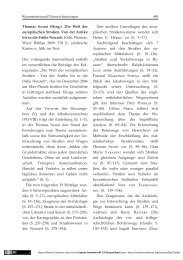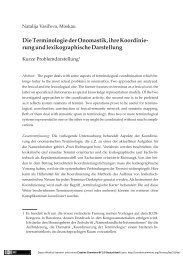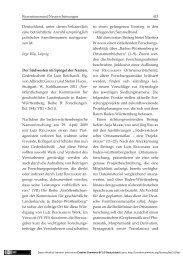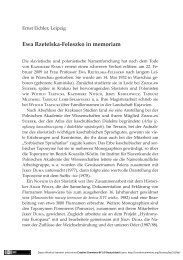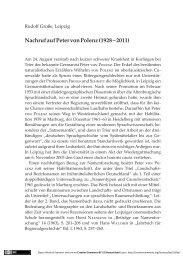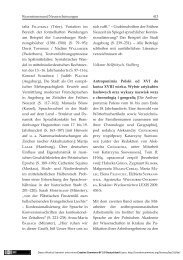Proper Names in the Light of Theoretical Onomastics
Proper Names in the Light of Theoretical Onomastics
Proper Names in the Light of Theoretical Onomastics
You also want an ePaper? Increase the reach of your titles
YUMPU automatically turns print PDFs into web optimized ePapers that Google loves.
92 V<strong>in</strong>cent BlanárThe above methods <strong>of</strong> research are applied as a part <strong>of</strong> <strong>the</strong> whole methodologicalapproach which takes <strong>in</strong>to account <strong>the</strong> l<strong>in</strong>guistic and ono masticstatus <strong>of</strong> proper names. The basic questions <strong>of</strong> onomastics, such as <strong>the</strong>character <strong>of</strong> a proper name, its onymic mean<strong>in</strong>g and content, onymic functions,onymic system and its functions <strong>in</strong> social communication, are <strong>the</strong>subjects <strong>of</strong> research <strong>of</strong> general l<strong>in</strong>guistics, <strong>the</strong> <strong>the</strong>ory <strong>of</strong> communicationand <strong>the</strong> <strong>the</strong>ory <strong>of</strong> onomastics. The general methodology comprises, e. g.<strong>the</strong> semiotic aspect <strong>of</strong> onomastics (<strong>the</strong> proper name as a l<strong>in</strong>guistic signsui generis), <strong>the</strong> method <strong>of</strong> system analysis and structural organi sation <strong>of</strong>proper names, <strong>the</strong> reconstruction <strong>of</strong> <strong>the</strong> model validity <strong>of</strong> onymic signs.Information and research flow (facts, methods, concepts) are not completed<strong>in</strong> <strong>the</strong>oretical generalisations (recognition <strong>of</strong> onymic (micro)systems).Parallel research <strong>in</strong>to <strong>the</strong> performance and functions <strong>of</strong> systems <strong>in</strong>ord<strong>in</strong>ary communication facilitates <strong>the</strong> track<strong>in</strong>g <strong>of</strong> <strong>the</strong>ir dynamics and relations<strong>in</strong> <strong>the</strong> course <strong>of</strong> <strong>the</strong>ir development and provides a new stimulationto deepen <strong>the</strong> recognition <strong>of</strong> both <strong>in</strong>terrelated sides <strong>of</strong> this complicatedphenomenon. Real proper names as elements <strong>of</strong> <strong>the</strong> onymic system anddynamic structure <strong>of</strong> <strong>the</strong> onymic system – its realisation <strong>in</strong> social communication– form an area <strong>of</strong> our scientific research.1. 3 A brief <strong>in</strong>sight <strong>in</strong>to research <strong>in</strong>to proper names as related to <strong>the</strong>development <strong>of</strong> philosophy and l<strong>in</strong>guistic th<strong>in</strong>k<strong>in</strong>gThe first ideas about proper names <strong>in</strong> European th<strong>in</strong>k<strong>in</strong>g were formulatedby <strong>the</strong> Ancient Greek philosophers. Some dist<strong>in</strong>ctions between appellativesand propria with<strong>in</strong> <strong>the</strong> NOMEN category were made by Aristotle.He dist<strong>in</strong>guished <strong>in</strong>dividual from general names and noticed that<strong>in</strong> proper names <strong>the</strong> significance <strong>of</strong> <strong>the</strong>ir appellative components isweakened. The proper name as a specific category <strong>of</strong> language was def<strong>in</strong>edby <strong>the</strong> Stoics, Chrysippos and Diogenes <strong>of</strong> Babylon (2 nd –1 st centuryB. C.), who provided <strong>the</strong> first def<strong>in</strong>ition <strong>of</strong> proper names. They termed itόνοµα. The Stoics def<strong>in</strong>ed <strong>the</strong> term proper name as designat<strong>in</strong>g an <strong>in</strong>divi -dual whose certa<strong>in</strong> mean<strong>in</strong>g is embodied <strong>in</strong> her/ his/ its specific characteristics(“ <strong>in</strong>dividual lekton ”). In appellatives, <strong>the</strong>se are general attributes,<strong>in</strong> proper names, <strong>the</strong>y are <strong>in</strong>dividual attributes. The semiotic mean<strong>in</strong>g <strong>of</strong>a proper name has its <strong>in</strong>itiator <strong>in</strong> Aurelius August<strong>in</strong>us, who anticipated<strong>the</strong> problems <strong>in</strong> communication, considered <strong>the</strong> first <strong>the</strong>ory <strong>of</strong> signs andformulated a remarkable def<strong>in</strong>ition <strong>of</strong> a sign. The first philologists and




